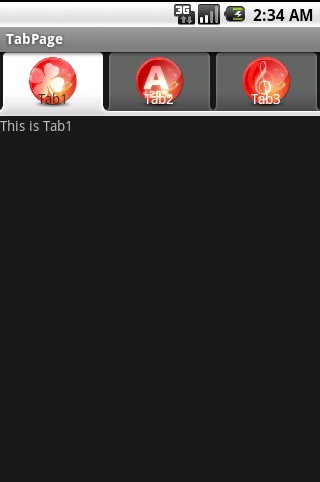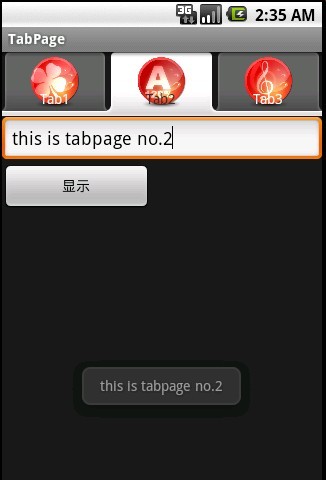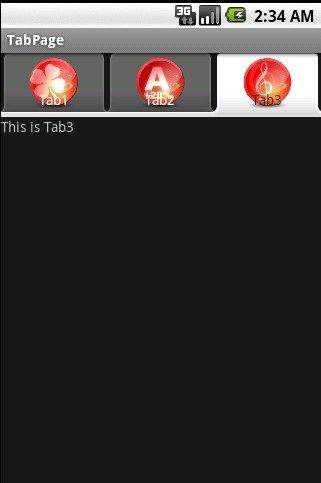在上一篇讲到了TabActivity和TabHost的结合的分页实现方式一。这里,将讲到方式二。其实,方式一、二大同小异,只是方式二的布局文件可以是独立的。当然,也有些差别,例如点击顶部Tab标签时页面跳转事件响应的实现也不同。具体,看源代码。
二、TabActivity和TabHost的结合实现分页标签--------方式二
细节分析:
1.主类继承TabActivity
public class Pagination extends TabActivity
2.获取当前TabHost对象
TabHost tabHost = getTabHost();
3.添加Tab分页标签
tabHost.addTab(tabHost.newTabSpec("Tab1")
.setIndicator("Tab1", getResources().getDrawable(R.drawable.a1))
.setContent(this));
........
这里,你会疑问,布局文件不用添加吗!确实,要添加,但是动态添加。即点击哪个Tab标签时,动态添加对应的布局文件。
public View createTabContent(String tag){..........}




1、布局文件:secondpage.xml
<?xml version="1.0" encoding="utf-8"?> <LinearLayout android:id="@+id/widget30" android:layout_width="fill_parent" android:layout_height="fill_parent" xmlns:android="http://schemas.android.com/apk/res/android" android:orientation="vertical" > <EditText android:id="@+id/et_text" android:layout_width="fill_parent" android:layout_height="wrap_content" android:text="EditText" android:textSize="18sp" > </EditText> <Button android:id="@+id/bt_show" android:layout_width="149px" android:layout_height="wrap_content" android:text="显示" > </Button> </LinearLayout>
2、代码文件:
package com.myandroid.test; import android.app.TabActivity; import android.os.Bundle; import android.util.Log; import android.view.LayoutInflater; import android.view.View; import android.widget.Button; import android.widget.EditText; import android.widget.TabHost; import android.widget.TextView; import android.widget.Toast; public class TabPage extends TabActivity implements TabHost.TabContentFactory { @Override protected void onCreate(Bundle savedInstanceState) { super.onCreate(savedInstanceState); //setContentView(R.layout.main); 这里不需要加载主页面 final TabHost tabHost = getTabHost(); //tab控制对象 tabHost.addTab(tabHost.newTabSpec("Tab1") //添加顶部的分页符 .setIndicator("Tab1", getResources().getDrawable(R.drawable.a1)) .setContent(this)); tabHost.addTab(tabHost.newTabSpec("Tab2") .setIndicator("Tab2", getResources().getDrawable(R.drawable.a2)) .setContent(this)); tabHost.addTab(tabHost.newTabSpec("Tab3") .setIndicator("Tab3", getResources().getDrawable(R.drawable.a3)) .setContent(this)); } /** * 点击Tab,跳转页面时激发的事件处理 */ public View createTabContent(String tag) { Log.e("tag", tag); //这里的tag字符串是tabHost.newTabSpec("Tab1") 定义的字符串 int tabPage = Integer.parseInt(tag.substring(tag.length()-1)); //获取最后面的数字 final TextView tv = new TextView(this); //要用final修饰,否则报错 tv.setText("This is " + tag); switch(tabPage) { case 1: //分页一 break; case 2: //分页二 final LayoutInflater layout = LayoutInflater.from(TabPage.this); //用于加载XML的对象,要使用final修饰 final View customView = layout.inflate(R.layout.secondpage, null); //创建自定义的View,要使用final修饰 final Button bt_show = (Button)customView.findViewById(R.id.bt_show); final EditText et_text = (EditText)customView.findViewById(R.id.et_text); bt_show.setOnClickListener(new Button.OnClickListener() { @Override public void onClick(View v) { // TODO Auto-generated method stub Toast.makeText(TabPage.this, et_text.getText(), Toast.LENGTH_SHORT).show(); } }); return customView; case 3: //分页三 break; default: break; } //不可以返回null return tv; } }
在下一篇,将继续讲到TabActivity和TabHost的结合实现分页标签--------方式三,也是较前两种方式好很多。

























 365
365











 被折叠的 条评论
为什么被折叠?
被折叠的 条评论
为什么被折叠?








